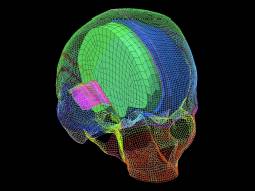Mehr Information
Hauptautor
Willinger, R.
Co-Autoren
Deck, C.
Medientyp
PDF-Dokument
Publikationsart
Vortrag
Erscheinungsjahr
2009
Verlag
18. EVU Conference, Hinckley
Literaturstelle
Willinger, R.: Model Based Head Injury Criteria Application to Head Injury Prediction. 18th EVU Conference, Hinckley (UK) 2009

Deutsch, 16 Seiten, 10 Abbildungen, 38 Literaturangaben
This paper presents an original numerical human head FE model followed by a validation against
human cadaver head impact tests from the literature. The human head FE model developed has two
particular features: one at the brain-skull interface level where fluid-structure interaction is taken into
account, the other at the skull modelling level, by integrating the bone fracture simulation. Validation
shows that the model correlates well with a number of experimental cadaver tests, including skull
deformation and fracture, intra-cranial pressure and brain deformation.
This state of the art numerical human head surrogate has then been used to simulate real world
accidents numerically . Helmet damage from thirteen motorcycle accidents was replicated in drop tests
in order to define the head’s loading conditions. A total of twenty two well documented American
football head traumas have been reconstructed, as well as twenty eight pedestrian head impacts and
six Formula I head traumata.
By correlating head injury type and location with intra-cerebral mechanical field parameters computed
from the model, it was possible to derive improved model-based head injury criteria and injury
risk curves for different injury mechanisms i. e. for skull fracture, subdural haematoma and neurological
injury. Illustration of how this new head injury prediction tool can contribute to injury
investigation and to head protection system optimisation is also provided.